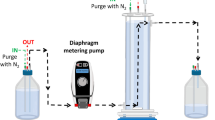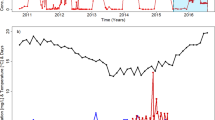Abstract
In anaerobic ammonium oxidation (anammox) systems, temperature may regulate the activity of functional bacteria (e.g., anammox bacteria) and the composition of the microbial population, ultimately determining the performance of the anammox reactor. Knowledge of the dynamic changes in nitrogen removal rates and the microbial anammox community at low and/or ambient temperature is still limited. This study explored the response of an anammox sequencing batch reactor (SBR) to a gradient of decreasing temperature (33, 25, 20, 15, 10 °C), followed by recovery to 22 °C, over 360 days. Particularly, the specific anammox activity (SAA) and microbial community were assessed. The anammox reaction in the SBR remained stable and efficient at 20–33 °C, with a total nitrogen removal load of 0.4 g-N L−1 day−1 and an SAA of > 0.32 g-N g-VSS−1 day−1; 10 °C was the turning point for the anammox bacterial metabolic activity, at which the SAA decreased by 91% compared with that at 33 °C. After the temperature was returned to 22 °C, the anammox activity recovered to 0.24 g-N g-VSS−1 day−1. The apparent activation energy for the anammox reaction was 68.4 kJ mol−1 at 10–33 °C and 152.9 kJ mol−1 at 10–20 °C. High-throughput sequencing results revealed that Kuenenia was the dominant species of anammox bacteria, and Kuenenia had a higher tolerance to low temperature than Candidatus Brocadia and Candidatus Jettenia. This study clearly shows the effectiveness of anammox bioreactors for treatment of wastewater at ambient temperatures of 15–33 °C.





Similar content being viewed by others
References
APHA (2005) Standard methods for the examination of water and wastewater. American Public Health Association, Washington
Awata T, Oshiki M, Kindaichi T, Ozaki N, Ohashi A, Okabe S (2013) Physiological characterization of an anaerobic ammonium-oxidizing bacterium belonging to the “Candidatus Scalindua” group. Appl Environ Microbiol 79:4145–4148
China SEPA (2002) Water and exhausted water monitoring analysis method, 4. China environmental. Science Press, Beijing
Dalsgaard T, Thamdrup B (2002) Factors controlling anaerobic ammonium oxidation with nitrite in marine sediments. Appl Environ Microbiol 68:3802–3808
De Clippeleir H, Vlaeminck SE, De Wilde F, Daeninck K, Mosquera M, Boeckx P, Verstraete W, Boon N (2013) One-stage partial nitritation/anammox at 15°C on pretreated sewage: feasibility demonstration at lab-scale. Appl Microbiol Biotechnol 97:10199–10210
de Graaff MS, Temmink H, Zeeman G, van Loosdrecht MCM, Buisman CJN (2011) Autotrophic nitrogen removal from black water: calcium addition as a requirement for settleability. Water Res 45:63–74
Dosta J, Fernández I, Vázquez-Padín JR, Mosquera-Corral A, Campos JL, Mata-Álvarez J, Méndez R (2008) Short- and long-term effects of temperature on the anammox process. J Hazard Mater 154:688–693
Egli K, Bosshard F, Werlen C, Lais P, Siegrist H, Zehnder AJB, van der Meer JR (2003) Microbial composition and structure of a rotating biological contactor biofilm treating ammonium-rich wastewater without organic carbon. Microb Ecol 45:419–432
He S, Chen Y, Qin M, Mao Z, Yuan L, Niu Q, Tan X (2018) Effects of temperature on anammox performance and community structure. Bioresour Technol 260:186–195
Hendrickx TLG, Wang Y, Kampman C, Zeeman G, Temmink H, Buisman CJN (2012) Autotrophic nitrogen removal from low strength waste water at low temperature. Water Res 46:2187–2193
Hendrickx TLG, Kampman C, Zeeman G, Temmink H, Hu Z, Kartal B, Buisman CJN (2014) High specific activity for anammox bacteria enriched from activated sludge at 10°C. Bioresour Technol 163:214–221
Hu Z, Lotti T, de Kreuk M, Kleerebezem R, van Loosdrecht M, Kruit J, Jetten MSM, Kartal B (2013) Nitrogen removal by a nitritation-anammox bioreactor at low temperature. Appl Environ Microbiol 79:2807–2812
Isaka K, Date Y, Kimura Y, Sumino T, Tsuneda S (2008) Nitrogen removal performance using anaerobic ammonium oxidation at low temperatures. FEMS Microbiol Lett 282:32–38
Jetten M, Horn SJ, Loosdrecht M (1997) Towards a more sustainable wastewater treatment system. Water Sci Technol 35:171–180
Kartal B, Rattray J, van Niftrik LA, van de Vossenberg J, Schmid MC, Webb RI, Schouten S, Fuerst JA, Damsté JS, Jetten MS, Strous M (2007) Candidatus “Anammoxoglobus propionicus” a new propionate oxidizing species of anaerobic ammonium oxidizing bacteria. Syst Appl Microbiol 30:39–49
Khramenkov SV, Kozlov MN, Kevbrina MV, Dorofeev AG, Kazakova EA, Grachev VA, Kuznetsov BB, Polyakov DY, Nikolaev YA (2013) A novel bacterium carrying out anaerobic ammonium oxidation in a reactor for biological treatment of the filtrate of wastewater fermented sludge. Microbiology 82:628–636
Kindaichi T, Yuri S, Ozaki N, Ohashi A (2012) Ecophysiological role and function of uncultured chloroflexi in an anammox reactor. Water Sci Technol 66(12):2556–2561
Kuenen JG (2001) Extraordinary anaerobic ammonium-oxidizing bacteria. ASM News 67:456–463
Kuypers MM, Sliekers AO, Lavik G, Schmid M, Jørgensen BB, Kuenen JG, Damsté JSS, Strous M, Jetten MS (2003) Anaerobic ammonium oxidation by anammox bacteria in the Black Sea. Nature 422:608–611
Li X, Du B, Fu H, Wang R, Shi J, Wang Y, Jetten MSM, Quan Z (2009) The bacterial diversity in an anaerobic ammonium-oxidizing (anammox) reactor community. Syst Appl Microbiol 32:278–289
Lotti T, Kleerebezem R, van Erp Taalman Kip C, Hendrickx TLG, Kruit J, Hoekstra M, van Loosdrecht MCM (2014a) Anammox growth on pretreated municipal wastewater. Environ Sci Technol 48:7874–7880
Lotti T, Kleerebezem R, Hu Z, Kartal B, Jetten MS, van Loosdrecht MCM (2014b) Simultaneous partial nitritation and anammox at low temperature with granular sludge. Water Res 66(1):111–121
Lotti T, Kleerebezem R, van Loosdrecht MCM (2015) Effect of temperature change on anammox activity. Biotechnol Bioeng 112:98–103
Ma X, Wang Y, Zhou S, Yan Y, Lin X, Wu M (2017) Endogenous metabolism of anaerobic ammonium oxidizing bacteria in response to short-term anaerobic and anoxic starvation stress. Chem Eng J 313:1233–1241
Miao L, Wang S, Li B, Cao T, Zhang F, Wang Z, Peng Y (2016) Effect of carbon source type on intracellular stored polymers during endogenous denitritation (ED) treating landfill leachate. Water Res 100:405–412
Morales N, Val Del Río Á, Vázquez-Padín JR, Méndez R, Campos JL, Mosquera-Corral A (2016) The granular biomass properties and the acclimation period affect the partial nitritation/anammox process stability at a low temperature and ammonium concentration. Process Biochem 51:2134–2142
Osaka T, Kimura Y, Otsubo Y, Suwa Y, Tsuneda S, Isaka K (2012) Temperature dependence for anammox bacteria enriched from freshwater sediments. J Biosci Bioeng 114:429–434
Pereira AD, Cabezas A, Etchebehere C, Araújo JCD (2017) Microbial communities in anammox reactors: a review. Environ Technol Rev 6(1):74–93
Ping Z, Xiangyang X, Baolan H (2004) New theory and technology of biological nitrogen removal. Science Press, Beijing
Quan Z, Rhee S, Zuo J, Yang Y, Bae J, Park JR, Lee S, Park Y (2008) Diversity of ammonium-oxidizing bacteria in a granular sludge anaerobic ammonium-oxidizing (anammox) reactor. Environ Microbiol 10:3130–3139
Strous M, Heijnen JJ, Kuenen JG, Jetten MSM (1998) The sequencing batch reactor as a powerful tool for the study of slowly growing anaerobic ammonium-oxidizing microorganisms. Appl Microbiol Biotechnol 50:589–596
Strous M, Fuerst JA, Kramer EH, Logemann S, Muyzer G, van de Pas-Schoonen KT, Webb R, Kuenen JG, Jetten MS (1999a) Missing lithotroph identified as new planctomycete. Nature 400:446–449
Strous M, Kuenen JG, Jetten M (1999b) Key physiology of anaerobic ammonium oxidation. Appl Environ Microbiol 65:3248–3250
Van de Graaf AA, de Bruijn P, Robertson LA, Jetten MS, Kuenen JG (1996) Autotrophic growth of anaerobic ammonium-oxidizing micro-organisms in a fluidized bed reactor. Microbiology 142:2187–2196
van der Star WRL, Abma WR, Blommers D, Mulder J, Tokutomi T, Strous M, Picioreanu C, van Loosdrecht MCM (2007) Startup of reactors for anoxic ammonium oxidation: experiences from the first full-scale anammox reactor in Rotterdam. Water Res 41:4149–4163
van der Star WRL, Miclea AI, van Dongen UGJM, Muyzer G, Picioreanu C, van Loosdrecht MCM (2008) The membrane bioreactor: a novel tool to grow anammox bacteria as free cells. Biotechnol Bioeng 101:286–294
Wang YY, Ma X, Zhou S, Lin XM, Ma B, Park HD, Yan Y (2016) Expression of the nirs, hzsa, and hdh genes in response to nitrite shock and recovery in Candidatus Kuenenia stuttgartiensis. Environ Sci Technol 50(13):6940–6947
Wang YY, Chen J, Zhou S, Chen Y, Lin XM, Yan Y, Ma X, Wu M, Han HC (2017) 16S rRNA gene high-throughput sequencing reveals shift in nitrogen conversion related microorganisms in a single-stage anammox system in response to salt stress. Chem Eng J 317:512–521
Yang Y, Zhang L, Cheng J, Zhang S, Li X, Peng Y (2018) Microbial community evolution in partial nitritation/anammox process: from sidestream to mainstream. Bioresour Technol 251:327–333
Zhang L, Narita Y, Gao L, Ali M, Oshiki M, Okabe S (2017) Maximum specific growth rate of anammox bacteria revisited. Water Res 116:296–303
Zhu G, Wang S, Ma B, Wang X, Zhou J, Zhao S, Liu R (2018) Anammox granular sludge in low-ammonium sewage treatment: not bigger size driving better performance. Water Res 142:147–158
Funding
This work was supported by the National Natural Science Foundation of China (NSFC) (nos. 51522809 and 51378370). The foundation of the State Key Laboratory of Pollution Control and Resource Reuse (Tongji University, China) (PCRRT16005) was also acknowledged.
Author information
Authors and Affiliations
Corresponding author
Additional information
Responsible editor: Gerald Thouand
Electronic supplementary material
ESM 1
(DOCX 102 kb)
Rights and permissions
About this article
Cite this article
Wang, W., Yan, Y., Song, C. et al. The microbial community structure change of an anaerobic ammonia oxidation reactor in response to decreasing temperatures. Environ Sci Pollut Res 25, 35330–35341 (2018). https://doi.org/10.1007/s11356-018-3449-1
Received:
Accepted:
Published:
Issue Date:
DOI: https://doi.org/10.1007/s11356-018-3449-1




